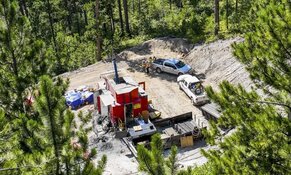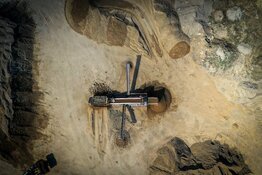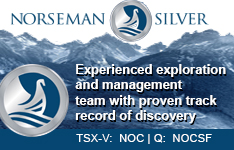Seabridge Gold Inc. (SEA:TSX; SA:NYSE.MKT) is a Canadian company engaged in acquiring and exploring gold properties located in the relatively stable mining jurisdictions of North America. The company's projects include Kerr-Sulphurets-Mitchell (KSM), Courageous Lake, 3 Aces, and Iskut, all located in various provinces across Canada, as well as Snowstorm in Nevada.
The KSM Project comprises four discrete claim blocks, including KSM claims, Seabee claims, Tina claims, and Treaty Creek Switching Station claims. It's located in the province of British Columbia and represents the world's largest undeveloped gold project and third-largest copper project measured by reserves and resources. An updated Preliminary Feasibility Study for the project estimates proven and probable reserves totaling 47.3 million ounces of gold and 7.3 billion pounds of copper.
Seabrridge Gold's Courageous Lake Property is approximately 240 kilometers (km) northeast of Yellowknife NWT, Canada, situated along the shores of Mathews Lake, between the larger Courageous Lake to the north and MacKay Lake to the south. This 3 Aces property consists of 1,536 Yukon Quartz Mining claims covering an area of approximately 31,400 hectares.
The company's Iskut Property is a contiguous block of mineral claims covering 22,238 hectares in British Columbia. At the same time, its Snowstorm Project encompasses 964 unpatented lode mining claims on roughly 2,245 hectares of leased private land in the Silver State.
The Catalyst: Defending From Pretenders
On November 20, Seabridge Gold reported that BC regulators had denied a request from Tudor Gold Corp. that the British Columbia government cancel a license and permit held by Seabridge's wholly-owned subsidiary, KSM Mining ULC (KSMCo).
The attempted usurpation was announced on July 17. At the time, Seabridge explained that the rights conveyed by the license and the relevant activities authorized by this permit were initially conveyed and authorized in September 2014 and include rights and authorizations to engage in certain activities on land to which Tudor only acquired mineral rights in 2016.
In its demand, Tudor claimed that the government did not have the power to issue this License and permit and argued that the license and permit destroyed the value of its own claims, arguments that Seabridge Gold management dismissed as frivolous and without merit.
"Work at KSM has been continuing as Seabridge aims to achieve its substantially started designation ahead of the 2026 deadline for the current Environmental Assessment Certificate," Red Cloud analysts Taylor Combaluzier and David A. Talbot explain.
According to that press release, "Mines Act permit M-245 authorizes various activities, including activities on claims held by Tudor along the route of the tunnels connecting the east and west sides of the KSM Project (the 'MTT'). The License provides KSMCo the right to occupy the area in which it intends to construct the MTT for the purpose of constructing the MTT."
"Once the MTT are constructed, the Licence will be converted into a statutory right of way for the entire length of the MTT, including the 12.5 km of the MTT that pass through mineral claims owned by Tudor."
When Tudor filed its demand, Seabridge Gold CEO Rudi Fronk said, "The argument that the B.C. government does not have the power to grant these authorizations is absurd. These types of authorizations are commonly used by the B.C. government to manage activities that take place on the government-owned land base."
"The Licence and authorization of the activities authorized by Permit M-245 to which Tudor objects have been in place for almost a decade," he continues, "and were granted after a thorough regulatory process that included participation by First Nations as well as Tudor's joint venture partners, American Creek Resources Ltd. and Teuton Resources Corp., who were the owners of the claims at the time."
At the time, Seabridge Gold management considered Tudor's submission "particularly unjustifiable given that the authorized activities and rights held by KSMCo that Tudor is claiming amount to the destruction of its property rights were in place and publicly known at the time Tudor acquired its interest in the Treaty Creek Property in June 2016. Accordingly, Seabridge will actively pursue the dismissal of Tudor's application."
Why This Sector? 'Friendshore' Gold Fits USA Demands
Gold remains an ideal investment commodity, whether in the ground or one's hands. Furthermore, for those investing in gold that's still in the ground, where that ground is located is essential.
Much of the world's in-ground reserves remain locked up in unsafe jurisdictions such as Russia, Uzbekistan, Indonesia, Mali, and the Democratic Republic of the Congo. These politically unstable regions can make investment inside their borders risky in the long run, as local politicians can alter extraction rules and limits on a whim.
In addition to potential government interference, banditry can be a problem in unsafe jurisdictions. An August 8 report for bnamericas explains, "Two major mining jurisdictions in Zacatecas state top the latest national ranking of Mexican cities with the highest perception of crime among the population: Fresnillo and Zacatecas."
According to independent risk and security management consultant Eduardo Ordóñez, "There are three or four cartels operating in the area that are constantly moving . . . The Jalisco Nueva Generación Cartel (CJNG) is established, the Cartel del Noreste is moving in, the Sinaloa Cartel is moving in, and there are some [guys] from San Luis Potosí who call themselves Los Alemanes."
Analyst Michael Siperco of RBC Capital Markets was equally bullish, noting that "Seabridge has begun to accelerate development of the world-class, large-scale, 100%-owned KSM gold/copper project in the 'Golden Triangle' region of northern British Columbia . . . with long-term upside potential."
"But why are they there? Zacatecas is one of the poorest states in the country and has some of the worst infrastructure. The highways to Zacatecas are terrible — [federal highway] 57 that connects to the northern states that border the United States is in extremely poor condition — but they're strategic for crime," he added.
As the article explains, "Of Mexico's 32 states, Zacatecas is ranked 28th in its contribution to the national GDP, with just 1% of the total."
"The low importance of the state to the legal Mexican economy contrasts with the fact that it is also the country's biggest producer of silver production and even displaced Sonora as the top gold producer in the first five months of the year, according to revised figures from the statistics bureau."
"Mexico's mining chamber (Camimex) recently complained that the high levels of crime in the country imply additional production costs of up to 10% for mining companies in terms of thefts and extra expenses on security measures."
"In recent years, organized crime has diversified from drug and migrant trafficking into activities such as robbery and extortion, increasingly focusing on companies and particularly those involved in mining precious metals and other minerals."
Ordóñez says, "In mining [crime] is a problem because they work with materials such as gold and silver, as well as construction materials such as gravel and sand, which are very attractive. You can demand fees from them for that. You can take away their control and force them to sell your material to launder money."
For example, he cites the armed takeover of one of First Majestic's gold and silver mines on the border between Zacatecas and Jalisco states in 2017. This takeover, allegedly by the CJNG, eventually forced First Majestic to halt operations in 2019
"They can get into your mine and take control," he explains, "but they can also steal materials, such as gold bars. Theft of materials is done by smaller groups, from helmets to pickaxes and more specialized machinery," said the consultant.
As you can see, if you're investing in gold that's still in the ground, which ground it's in is incredibly important.
Why This Company? Successfully Defended Enormous Claims
While Tudor Gold's regulatory challenge was not an armed attempt to derail production at any Seabridge Gold project, it could certainly be classed as the white market equivalent of such a hostile threat.
Regardless, the saner heads of a well-managed jurisdiction prevailed, and the request was unsuccessful.
As Seabridge Gold's latest press release recounts, "In its response to Tudor's application to cancel the permit, the BC Ministry of Energy, Mines, and Low Carbon Innovation confirmed the BC Government's authority to issue permits within an area where mineral title is held by a third party."
"In its response to Tudor's application to cancel the Licence, the BC Ministry of Water, Land, and Resource Stewardship confirmed there is no basis to cancel the license under the provisions of the relevant legislation or the terms of the Licence."
According to CEO Fronk, the Seabridge Gold team members "are pleased that the B.C. government is taking no action on Tudor's request."
"We understand that in granting authorizations such as the license and the permit, the BC Government will consider the impacts on third parties such as Tudor and protect the rights of third parties, which it has done," he continued, "but in confirming our Licence and the permit, we believe it is acting in accordance with the best interests of the people of BC."
Why Now? With Challenge Quashed, Opportunity Awaits
On November 21, Red Cloud analysts Taylor Combaluzier and David A. Talbot wrote about the latest jurisdictional development in a private research note.
In it, the analysts expounded on their suspicion that the request to cancel the license was an opportunistic move by Tudor Gold with little grounds.
"Work at KSM has been continuing as Seabridge aims to achieve its substantially started designation ahead of the 2026 deadline for the current Environmental Assessment Certificate," they explain.
The report gave Seabridge Gold a Buy rating and a CA$ 45.25 target price, representing a possible 186% increase from the share price at the time of the report, which was CA$ 15.80.
Writing in September, while the dispute was still underway, analyst Michael Siperco of RBC Capital Markets was equally bullish, noting that "Seabridge has begun to accelerate development of the world-class, large-scale, 100%-owned KSM gold/copper project in the 'Golden Triangle' region of northern British Columbia . . . with long-term upside potential."
"At full production, KSM would be a Top 5 annual gold producer (Top 10 Au eq) with resources that could support a mine life of 100-plus years," he explained. "Seabridge has CA$ 203 million in cash exiting Q2/23, in our view sufficient to take the project through to substantially completed status (potentially by early 2025) and to a construction decision, pending any partnership agreements in the interim."
 Streetwise Ownership Overview*
Streetwise Ownership Overview*
Seabridge Gold Inc. (SEA:TSX; SA:NYSE.MKT)
"We think generational gold/copper assets in good mining jurisdictions are hard to find and harder to advance," wrote Siperco, "making KSM a potentially attractive option for producers looking for long-term, consistent production potential."
Ownership and Share Structure
Seabridge Gold has a market cap of CA$ 1.32 billion with some 82.4 million shares outstanding, 79.95 million of those free-floating. It trades in a 52-week range of CA$21.78 and CA$13.34.
About 36% of the company is held by institutional investors, while management, board members, and company insiders own approximately 25%, the company said. CEO Fronk owns 1.49% or 1.21 million shares, according to Reuters. The rest is retail.
Sign up for our FREE newsletter
Important Disclosures:
- Seabridge Gold Inc. is a billboard sponsor of Streetwise Reports and pays SWR a monthly sponsorship fee between US$4,000 and US$5,000.
- Owen Ferguson wrote this article for Streetwise Reports LLC and provides services to Streetwise Reports as an independent contractor.
- The article does not constitute investment advice. Each reader is encouraged to consult with his or her individual financial professional and any action a reader takes as a result of information presented here is his or her own responsibility. By opening this page, each reader accepts and agrees to Streetwise Reports' terms of use and full legal disclaimer. This article is not a solicitation for investment. Streetwise Reports does not render general or specific investment advice and the information on Streetwise Reports should not be considered a recommendation to buy or sell any security. Streetwise Reports does not endorse or recommend the business, products, services or securities of any company mentioned on Streetwise Reports.
For additional disclosures, please click here.





































